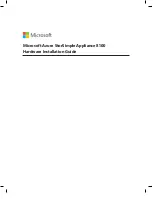
Migrating
data
from
an
eServer
i5
400
or
iSeries
host
system
to
the
DS8000
Use
the
following
information
as
a
guide
to
determine
how
to
migrate
data
from
an
eServer
i5
400
or
iSeries
host
system
to
the
DS8000.
When
you
create
the
eSeries
i5
400
or
iSeries
volume,
you
can
create
it
as
a
protected
or
unprotected
volume.
This
creation
enables
you
to
see
the
protected
and
unprotected
models.
Unprotected
models
can
be
software
mirrored.
DS8000
supports
2107
device
types
with
model
A81-A87
(unprotected)
and
A01-A07
(protected)
and
you
need
a
level
of
OS/400
that
supports
these.
The
model
numbers
correspond
to
8.56
GB
(A01/A81),
17.54
GB
(A02/A82),
35.16
GB
(A05/A85),
36
GB
(A03/A83),
70.56
GB
(A84/A04),141.12GB
(A86/A06),
and
282.25
GB
(A87/A07).
eSeries
i5
400
and
iSeries
hosts
require
a
separate
device
address
for
each
drive
in
the
subsystem.
The
DS8000
meets
this
requirement
by
reporting
unique
addresses
for
each
virtual
drive
that
is
defined
to
the
eSeries
i5
400
or
iSeries
host.
32
LUNS
per
iSeries
FC
adapter
are
supported
by
the
on
the
OS/400
as
well
as
multipathing
to
a
storage
unit.
Because
the
eSeries
i5
400
or
iSeries
host
does
not
support
7133
drawers,
you
have
no
existing
7133
drawers
to
reformat.
If
you
have
an
existing
disk
subsystem
that
you
are
replacing
with
a
DS8000,
you
must
migrate
the
data
to
the
DS8000.
Use
your
existing
host
utilities
for
the
data
migration.
You
can
select
from
several
methods
to
migrate
data
to
the
DS8000:
v
You
can
use
the
logical
add
and
remove
functions.
v
You
can
use
save
methods
and
restore
methods
with
tape
devices.
You
can
also
use
these
methods
if
you
remove
an
existing
disk
subsystem
before
you
install
the
DS8000.
Note:
From
a
DS8000
logical
configuration
viewpoint,
all
eSeries
i5
400
and
iSeries
volumes
are
RAID
5
and
are
protected.
When
you
create
the
eSeries
i5
400
or
iSeries
volume,
you
can
create
it
as
a
protected
or
unprotected
volume.
This
creation
enables
you
to
see
the
protected
and
unprotected
models.
Unprotected
models
can
be
software
mirrored.
Migrating
data
from
an
S/390
or
zSeries
host
system
to
the
DS8000
storage
unit
You
can
use
various
methods
to
migrate
data
from
an
S/390
or
zSeries
host
system
to
a
DS8000
storage
unit.
The
correct
method
depends
on
your
environment
and
system.
The
following
table
highlights
a
few
of
the
data
migration
methods
available:
Environment
or
Operating
System
Data
Migration
Method
S/390
environment
IBM
TotalStorage
z/OS
Global
Mirror,
Remote
Mirror
and
Copy
(when
available)
zSeries
environment
IBM
TotalStorage
z/OS
Global
Mirror,
Remote
Mirror
and
Copy
(when
available)
134
DS8000
User’s
Guide
Summary of Contents for TotalStorage DS8000
Page 1: ...IBM TotalStorage DS8000 User s Guide SC26 7623 03...
Page 2: ......
Page 3: ...IBM TotalStorage DS8000 User s Guide SC26 7623 03...
Page 10: ...viii DS8000 User s Guide...
Page 12: ...x DS8000 User s Guide...
Page 14: ...xii DS8000 User s Guide...
Page 24: ...Department 61C 9032 South Rita Road TUCSON AZ 85775 4401 xxii DS8000 User s Guide...
Page 26: ...xxiv DS8000 User s Guide...
Page 50: ...24 DS8000 User s Guide...
Page 116: ...90 DS8000 User s Guide...
Page 120: ...94 DS8000 User s Guide...
Page 152: ...126 DS8000 User s Guide...
Page 166: ...140 DS8000 User s Guide...
Page 184: ...158 DS8000 User s Guide...
Page 186: ...160 DS8000 User s Guide...
Page 192: ...Taiwan class A compliance statement VS07171L 166 DS8000 User s Guide...
Page 227: ......
Page 228: ...Printed in USA SC26 7623 03...
















































